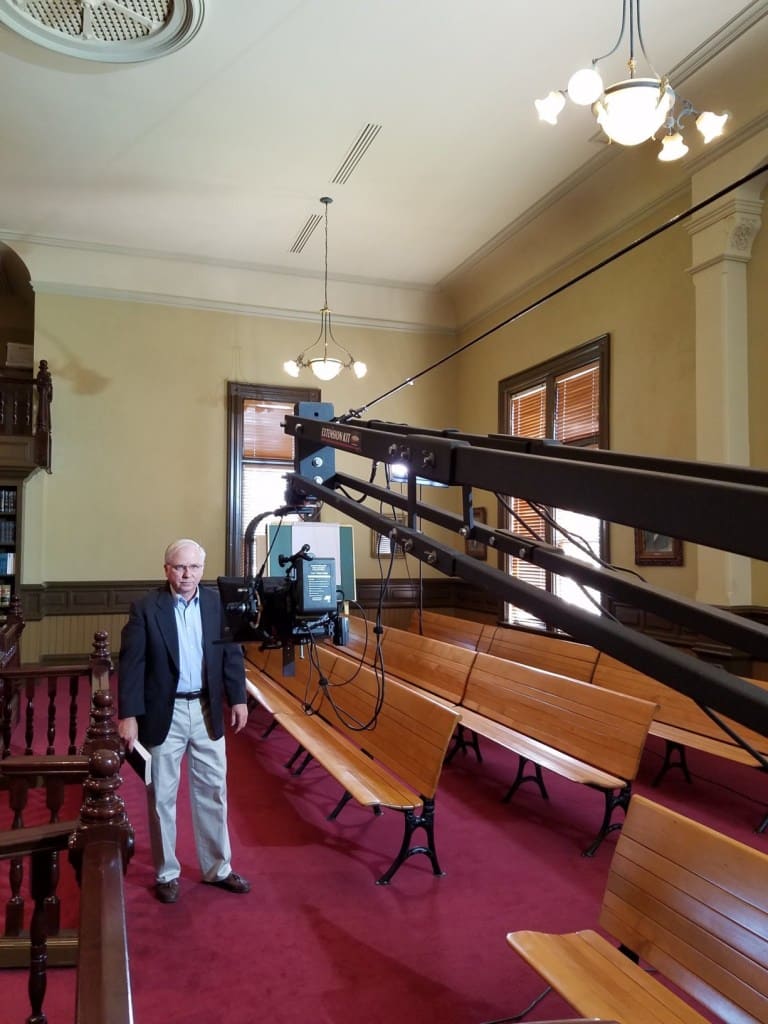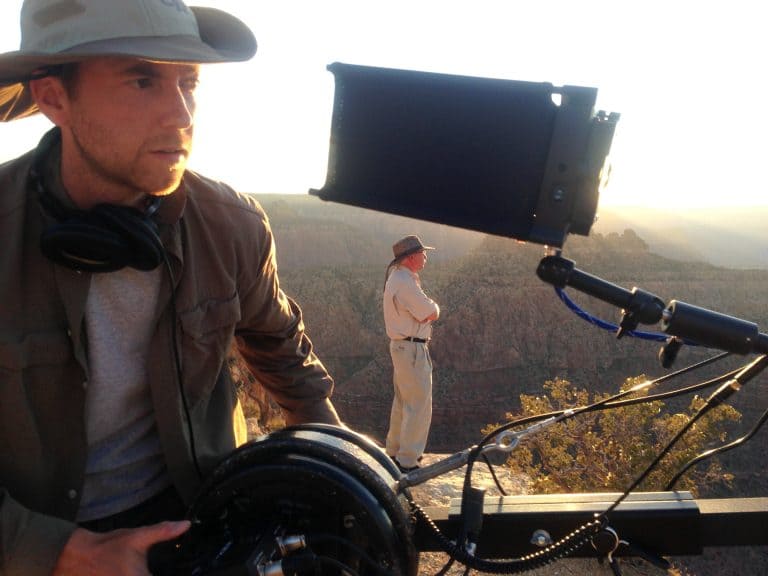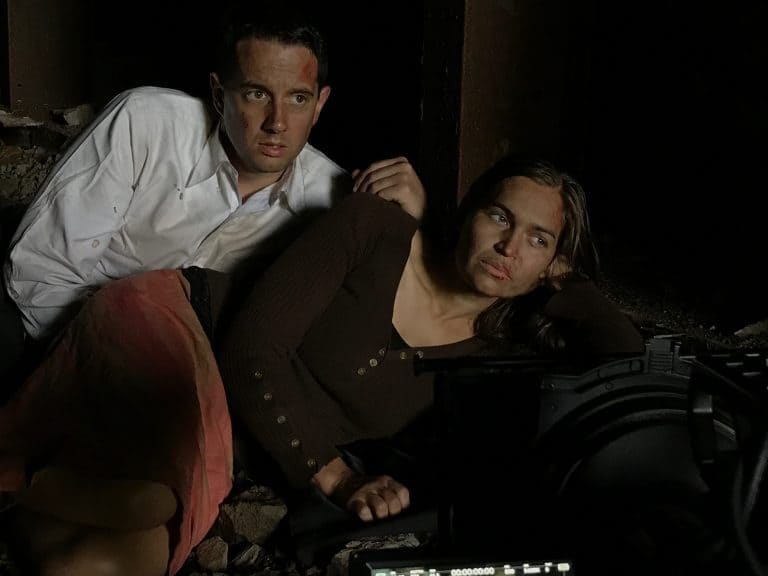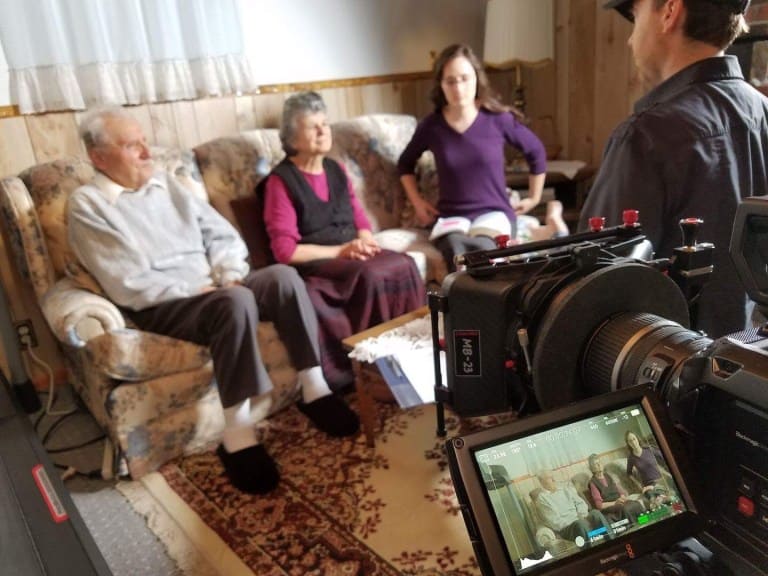


2009
In the spring of 2009, Jeff Reich and Michael McCaffrey were discussing possible projects for the future, one of which was The Days of Noah. It would be a film that would investigate the evidences from the Flood and parallel the message of Noah with the Three Angels Messages’ at the end of time. It would bring to view the evidence of the past judgment that would also serve as a warning to us, of a judgment to come. Later that summer, production on The Days of Noah began. It was August 10th in 2009 when the first shot was captured. It was a shot of light rays from the sun piercing through a smokey forest due to a nearby forest fire in Arizona. We were on our way to Phoenix for the ASI convention and decided to leave a few days earlier so we could do some filming in the Grand Canyon. In the fall of 2009, we did some more filming and once back home we continued to develop the project.

2010-2011
In 2010 and 2011 we continued to travel and produce mission videos from our projects in Vanuatu, the Philippines, North India, South India and Lithuania, all the while, continuing to develop and formalize our plans for The Days of Noah. In 2011 it was decided the documentary film would consist of four major sections. In the first section, we would examine and re-tell the Flood story as found in the book of Genesis. In the second section, we would investigate the physical and historical evidences for the Flood, as this would establish the credibility of the Biblical record and lay a foundation for the judgment to come. In section three we would take a look at how these evidences have been buried and re-interpreted to bring the geologic record into harmony with an atheistic worldview, and this would in-turn, lead us into section four, dealing with the parallels between Noah’s story and the Three Angels’ Messages — the first of which, is a call to “worship him that made heaven, and earth, and the sea, and the fountains of waters.” (Rev 14:7)

2012
With our final plans for the film in place we began to purchase the equipment we needed in May of 2012. That summer, we traveled the country filming both places of geologic interest and interviews of scientists, pastors, historians and theologians. For this we traveled through Utah, Arizona, California, Oregon, and Washington. In the fall of 2012 work began implementing our plans to create an illustrated animation sequence re-telling the story of the Flood as it is found in the Bible and in the book Patriarchs and Prophets. It took several weeks to create a list of 128 shots that would make-up the 16 minute long sequence; each shot lasting on average, 7.5 seconds.

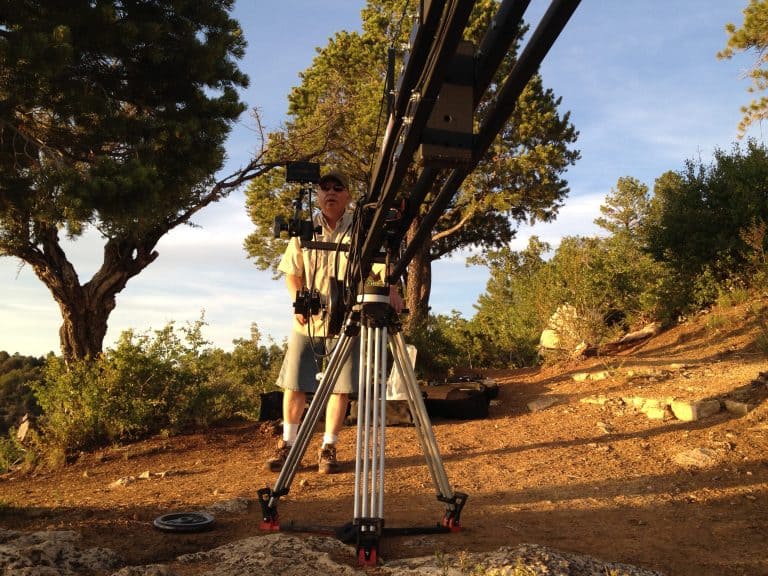
2013
In 2013 these shots were storyboarded and the search began to find a company that would create the final illustrations for the sequence. Once the team of 10 artists, illustrators and compositors were hired, it took another 32 months to take each of the 128 images through all its stages, from the storyboard to the sketch, then to the line-art, then to color, and finally into animation, with revisions at each stage along the way.
In the spring, filming continued in the Grand Canyon. We spent some time on the north rim and the south rim of the Grand Canyon filming on-camera narrations with Jeff discussing the formation of the canyon and visible evidences that resulted from the Flood. Unlike most other places on Earth, the Grand Canyon offers us some insight into the early ages of Earth’s history as some of the sedimentary layers and rocks exposed there are not seen anywhere else on the planet.

In June of 2013 Chris Tempel was hired to help maintain the production of the ministry’s mission videos while Mike continued to work on the documentary. When in-between mission videos, Chris has also taken on 3D animations and visual effects work for The Days of Noah. Eventually, the task at hand was so large that it required his full-time work on the project as well.As work on the animation sequence for the Flood continued, we traveled once again to California, this time to Amazing Facts to film additional interviews and narrations with Jeff on the coast and in the Redwood forest. Back home in Idaho in September of 2013, production began on the re-enactments of William Miller discovering the 2300 day prophecy. In The Days of Noah we chose to introduce the viewer to the 2300 day prophecy through the life and experience of William Miller. His thoughts, his trials and discoveries, through much prayer and study lend both color and inspiration to the presentation of this prophecy. These re-enactments also came with large challenges largely created by undertaking the filming of a period piece. We would need to research and find wardrobe, make-up, quill pens, old bonded paper, an 1800’s era Bible, books, props and an old farm house to film in.

After several unsuccessful location scouts, we decided to build a set in our TV studio. Then the search commenced for an old 1800’s era farm house for the exterior shots, which we found in Boise Idaho. In October we also filmed the experience of Hiram Edson and O.R.L. Crosier as they came to understand the revelation about the Heavenly sanctuary – one that would finally help them, and also those viewing The Days of Noah through their experience, to understand true meaning of the prophecy in Daniel 8:14, “unto two thousand and three hundred days; then shall the sanctuary be cleansed” and its relationship to the judgment to come.


2014
2014 also saw the commencement of another gigantic endeavor – building and animating a 3D model of the earthly sanctuary. Parallels between the Ark of Noah and the sanctuary are of paramount importance as they are both lesson books through which God designs to teach us how He can provide mercy in the midst of judgment. Both are illustrations of the plan of salvation. Finding a way to illustrate these truths within the context of the sanctuary was paramount in helping the viewer to contextualize the significance and importance of the Truths revealed in the Most Holy place – namely the law of God and the crisis that would culminate upon this issue. “The last great conflict between truth and error is but the final struggle of the long-standing controversy concerning the law of God. Upon this battle we are now entering—a battle between the laws of men and the precepts of Jehovah, between the religion of the Bible and the religion of fable and tradition.” – The Great Controversy p582.2
After much research and searching, we found that hiring a company to model, light, texture and animate the shots needed, would be far more expensive than what we had to spend. Eventually we found and were able to purchase just the 3D models of the earthly sanctuary, and we embarked on the work of doing all the texturing, lighting and animation work ourselves. This of course, took more time – a lot more time, and would bring us head to head with far more trials and technical challenges than we anticipated.

One such struggle involved the look and design of the presence of God in the Most Holy place. The software we were using to build up the sanctuary is called Blender, but it seemed incapable of producing a fiery presence like we wanted. After further research and exploration we found another piece of software (LightWave) that would produce the look we needed, but integrating the camera movement, and reflections generated by the presence of God from one program, into the other program was a challenge in itself. There were additional challenges trying to find a way to animate a pillar of fire and a pillar of cloud. Generating supernatural elements such as these with software typically designed to mimic real-life conditions and behavior was not easy. Still, we pressed forward. Creative challenges, technical challenges and computer problems consisted of a typical day’s work. On top of all this, Mike was still corresponding with the artists and illustrators working on the Flood story animation sequence on a daily basis. As challenging as it was to juggle several large projects on multiple fronts, yet another large unforeseen battle was still ahead. The necessary, but troublesome task of assembling a renderfarm.

2015
All video consists of multiple still images playing quickly together like a high-tech flip-book. Every single still image produced of the 3D sanctuary, was taking about 45 minutse to render. Some animations took more than two hours per image to render. A five second animation for example would consist of 120 still images, taking about 90 hours of render time. And in order to complete some shots with smoke or fire, we needed multiple passes, which means we needed to render the shot once without the altar of sacrifice, and once with the altar of sacrifice and the smoke by itself on its own layer. With hundreds of shots ahead of us, we knew we needed more computers! Research began to figure out how we could network together multiple computers and have them all working on rendering the same animations. The technical obstacles were, it seemed, without number. Literally hundreds and hundreds of various technical challenges had to be overcome. Some small and insignificant, others daunting and overwhelming. Without a large team to rely on, each of these tasks took Mike and Chris away from editing and away from our primary projects. Sometimes, in order to move forward, we had stop what we were doing, and take on yet another large project, to aid in the progression of our primary endeavors. Still, we pressed forward. After about three months, we finally had networked together eight computers. Some of which were old machines we had at the ministry, and some we built ourselves using components purchased online. In all, by the end of the project we ended up with 11 machines. So an animation requiring 90 hours of rendering, would instead, take only 8.1 hours! What a difference a few computers can make!
In 2015 the design and build of the 3D sanctuary was finally complete, and with a working renderfarm in place, animations on the sanctuary began. While also juggling other responsibilities, the sanctuary animations took 12 months to complete.

In 2015 we brought on another artist to create paintings for The Days of Noah. Sarahi Remolina, an artist and painter began the work of painting specific scenes we needed to illustrate the story of Noah. For this project, she completed 31 amazing original paintings. Sarahi’s talent and passion for glorifying God can be seen in the details of her artwork. An enormous amount of time and effort goes into every painting, and it shows. Work on these paintings began in 2015 and was completed in 2018.
As Chris undertook the work of the sanctuary animations, Mike was able to complete the bulk of the editing for The Days of Noah. The 18 hours of interview footage, and several more hours of on-camera narrations, and b-roll footage were assembled to tell the grand story of the Flood from type, to anti-type. In the editing process, we realized it would take a lot more screen time to reasonably establish the truths that were necessary to bring the viewer through the four sections we had planned for the film. We wanted to bring the viewer on a journey, that would place them upon a precipice from which they could view the scope of history and prophecy together as one whole, and gain a perspective from which they could understand the subject of judgment and salvation as one coherent story, in type and anti-type.

Instead of a presentation made up of isolated doctrines and events, we wanted the viewer to be able to walk away from this film with an understanding of how the prophecies of the past, present and future all work together seamlessly to tell the story of God’s heartbreak due to sin, His sacrifice and His efforts to redeem the race He created in His own image. To bring a viewer with little to no understanding of the Bible on such a journey, and give them such a vantage point of human history that they might see the threads of God’s design woven through the ages, even to our own day, and thereby comprehend their need to heed the last message of mercy given by the Three Angels’ Messages, would require leading them carefully “precept upon precept,” and “line upon line.” (Isa 28:10) If, at the end of the film, the viewer has been presented with a message of warning, but does not comprehend the bigger picture and how these warnings relate to the past or the future, how will they walk away from the film with the faith necessary to make bold decisions for God in the present? We decided, rather than cut The Days of Noah down to one 90 minute film and diminish the meaning and scope of the warning message, we would take the time to present the information necessary to bring the viewer to the precipice of prophecy – that they might comprehend the story of Noah, the history and prophecies of scripture within the context of all time, past, present and future.
Only after summiting, can we gain a true appreciation for where we’ve been, what we’ve gone through, and where we are going. Only upon summiting, can one clearly see the magnitude of the storm upon the horizon that those in the valley cannot comprehend. This, is what makes The Days of Noah truly unique. And to preserve the big picture we needed to split up The Days of Noah into a series of multiple films.

2016
Trying to determine the best way to visually present the relationship of these prophecies from Noah’s day and our own concerning the judgment hour message and its warning was no easy task. It was discovered that if every year that has transpired from Noah’s time to our own were represented as one inch, then a timeline would span almost the exact length of a football field from the end of one end-zone to the other. With this in mind, a 3D timeline along a football field seemed like a great way to illustrate when these events occurred while maintaining context, perspective and scale.

To accomplish this objective, in 2016, we spent three weeks filming at a football field in St. Maries Idaho at night. With the sun down, the lighting and weather was more easily controlled, ensuring that our shots spanning three weeks of filming would all match. Yellow tennis balls were placed on the field to help the computer to track the shots so the 3D timeline could be added in later and maintain the proper motion and perspective. Pink tennis balls were placed on stakes representing the horizontal height of the timeline so Jeff could interact with the 3D elements when speaking.
With the interviews and content of The Days of Noah now edited, we knew exactly what footage we would need to complement the subjects discussed. We set out on one last trip to the southwest. Mike and Chris traveled through to Wyoming to film a dinosaur dig, and to Denver, Black Canyon National Park, and Utah and Montana to film specific geologic evidences for the flood, b-roll of the cities and footage for various visual effects shots. This trip alone was a journey of 4,671 miles and 95 hours of driving. It also involved one flat tire due to a nail, and one malfunctioning drone that fell from the sky, but still, we pressed forward.



2017
January of 2017 presented yet another large project. As winter set in, and with the new footage from 2016 edited into the film, our attention was turned to pre-production for b-roll scenes that would accompany the interviews as they discuss different subjects in the film. These included simple scenes from Bible studies and ministering to the homeless, to more complicated scenes depicting the arrest, imprisonment and tribulations of saints during the seven last plagues leading up to the second coming of Christ. The task of producing this material included organizing and scheduling over a hundred scenes, with around 70 cast members and dozens of locations that when edited together, would span four different feature length films in The Days of Noah series. As much time and effort as it took, this also was the least expensive way for us to acquire the visuals we needed to tie the documentary together. Throughout this process we gained cast members and lost cast members, gained locations and lost locations and through the spring rains and weather we still pressed forward. We knew God always gave us the weather we needed, because, when filming wrapped, the weather often immediately changed for the worst.
In June and July post-production work continued, editing in stock footage and b-roll, as well as editing the scenes filmed in the spring. Mike began undertaking the remaining 3D animations for part 3. These include 3D animations of the sanctuary, 3D Bible verses and a 3D cathedral. Month after month after month for 4 years, our ten computers have nearly been rendering animations around-the-clock. In all, there are 425 animations in the four parts of The Days of Noah series.
Also in June, Chris Tempel began work integrating the 3D timeline (illustrating the prophecies of scripture), with the footage of Jeff on the football field. This is in itself was also an enormous undertaking, tracking 106 shots and removing from the footage, tennis balls and stakes used during filming as placeholders for the 3D elements. Then the 3D elements are integrated into the shots. This process itself too nearly a year to complete.

In September, Jeff, Mike and Chris drove out to Seattle to the coast and to Hurricane Ridge to complete the last of the on-camera narrations. We were blessed with tremendous weather and scenery to film some of these scenes on the top of a spectacular mountainous ridge-line. Road construction on the way there was a set back, and by the time we arrived on top of the mountain, we had several hours of filming to do and about 2 hours of daylight, but still, we pressed forward. With the narrations complete, production for The Days of Noah was finally wrapped in September of 2017.
In July, our voice over artist, Rod Howard (right) was given all the remaining voice overs for the films. In totality, the film series includes about 200 different voice overs from Rod.
With the 3D animations, voice overs, timeline shots, paintings, b-roll scenes and narrations complete or almost complete, the film really began to take shape. Now, instead of listening to temporary voice over recordings and seeing black spots where b-roll or visual effects shots would go, the elements and footage were in place and the films were coming together.

2018
In the fall of 2017 to the spring of 2018 Mike began moving the edited films from the editing software (Adobe Premiere Pro) to DaVinci Resolve for color-grading and finishing. This process of bringing a film into another piece of software for finishing is called “conforming.” Due to technical challenges, the edit from Premiere would not come into DaVinci Resolve without major issues. With the several hundreds clips on the timeline, all the audio would come in out of sync, the still images in the timeline would be out of place and would sometimes overwrite other edits in the film and text elements and titles created in Premiere would not come into DaVinci Resolve. For each film, the audio for every single clip had to be manually replaced, and the still images re-edited in DaVinci Resolve using the timeline from Premiere for cross-referencing. For each film, this process took about 2 weeks.
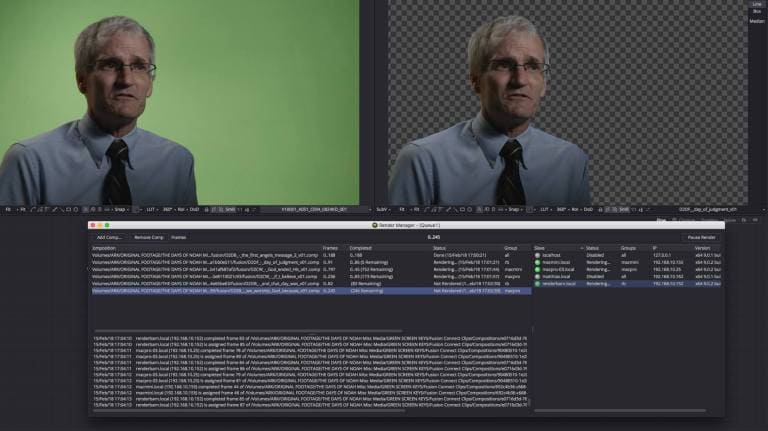
Once the films were all conformed and inside of DaVinci Resolve, they were ready for finishing. The first step in the finishing process was replacing all the green screens behind the interviewees with the matte paintings that were created to make it look like they were sitting inside the Ark. This process took roughly 1.5 weeks per film, or 6 weeks for the entire series. Replacing the green screens alone came with its own set of challenges. A key for each interview could sometimes take hours to put together, but once perfected, the settings could be easily applied to other clips with the same individual.

The second step in the finishing process was the color-grading. This meant adjusting things such as the colors, brightness and contrast and saturation for each shot. Some of the enacted scenes required more work to reproduce a certain look, or to make a daytime shot appear as though it were night. Each film took about 2 weeks to color grade, with the final scene in part 4 taking about 2-3 weeks by itself because of lighting effects that were added onto the actors themselves that did not exist at the time of filming. The third step in the finishing process was finalizing and purchasing stock footage. The film was edited with low resolution previews of video clips that had to be purchased and edited into the film. The fourth step in the finishing process involved audio. Foley effects and various sound effects were added to accompany the visuals. This step took about a week or two per film. The fifth step was to mix the audio levels for each film. Dialogue, sound effects and music all needed to be mixed and finalized.

The sixth step was to finish the music. As with the stock footage, throughout the editing process free versions of royalty free music were added to the film. These free versions of the music tracks come with watermarks (a voice over the music itself). Since the films were in the editing process for so long, by the time the music was ready to be purchased, some of the music tracks no longer existed for sale. In cases like this, new music had to be found, and the music itself often needed to be edited to fit the films. With all of these steps each taking several weeks or longer, sometimes even per film, the year was largely spent bringing all four films from their rough edited stage to finished films. With the green screens in place, the color-grading done and the stock footage and music purchased and finished, only one thing remained before the films could be complete and that was finishing the visual effects shots. Through the years, finding qualified freelancers willing to work within our budget constraints on a Christian film was a real challenge.
At one point we had the cooperation of a prestigious visual effects house, but in the end, their paid jobs took priority and we had to look elsewhere for help. To finish the visual effects shots, various computer generated fire assets needed to be created. These included fireballs, burning buildings, smoke and other elements. In the end, God helped us find a fantastic, committed and talented helper in the most unlikely of places — YouTube. Jake Bashore, a young manager at a Little Caesars Pizza restaurant has a passion for creating 3D digital fire elements and explosions. He has spent years learning how to create these elements, and as a Christian himself, he was thrilled to be a part of this project and helped create several animations for us, including a 3D animation of The Days of Noah title rising up out of the ocean in 3D for part 1, The Flood.

2019
In 2019 the last big project was completing the last of the 205 visual effects (VFX) shots in the films, not including the green screen shots. Of all the VFX shots, 106 were the 3D timeline and the rest consisted of such things as painting out objects, people or dogs in the background or adding in objects, such as stormy skies, fireballs, and digital trees or bushes, etc. Chris Tempel (left) took on the job of what would normally be delegated to multiple teams of people. By early March, the last of the VFX shots was completed and he began work began on authoring the DVD and Bluray discs.
Also in early 2019, nearly completed versions of the films were sent to multiple screeners — people who would watch the films and give us constructive feedback. This feedback was considered and final changes were made to the films in March. At this time, Mike also edited the trailer for The Days of Noah and designed and put together a website for the films.
At the time of this writing, it will not be long and the films will be available for purchase or to rent online. We are excited about this project and we are excited to see what the Lord will do with it. This project has been an epic journey for all of us. We have pressed forward through enormous and unrelenting technical challenges, through bad weather, bad roads, disappointment, trial, stress, setbacks and often times lack of means, lack of time, lack of help and lack of funds.
There have been times throughout the course of this project where we have taken a look at the film, seen all the black gaps and white text describing where the scenes, the narrations and animations would eventually be. We would listen to the film and hear scratch audio, temporary voice overs and un-mixed and un-edited music, and seeing and hearing all these things would be overwhelming considering all the work still to be done. One could not help but wonder if the daunting and to some degree, crushing prospect of the work yet to be done was how Noah felt as he undertook the building of the Ark. It’s still hard to imagine the patience of Noah, beginning a project that would take him 120 years to complete. Staggering as The Days of Noah project has been, it doesn’t take long to realize, even this endeavor, cannot compare to the faith and commitment of this patriarch. It is one thing to intellectually understand the work that Noah undertook, but how different it would be to walk in his shoes for a day — or for a century! Years ago I think we were all ready to be finished with this project, but we pressed forward.
For those of you who have walked along with us, supporting us and praying for us we cannot thank you enough. By your support and prayers God has sustained this project and seen it through many precarious circumstances. We cannot wait, to see how the Lord will use this project in your lives, and in the lives of those we all share this message with. We believe eyes will be opened, hearts will be reached and the population of Heaven will increase and all our trials will be more than worth it – and truly, that, is the big picture. As we all sacrifice our time, money, effort and energies to bring this message before our family members, our friends and loved ones who know not these things, let us remember the promise “They that sow in tears shall reap in joy.” (Psa 126:5) It is our desire that these films will help prepare you and your loved ones and neighbors to enter the Ark of refuge and be ready for the judgment to come — just as did God’s faithful patriarch in the days of Noah.


